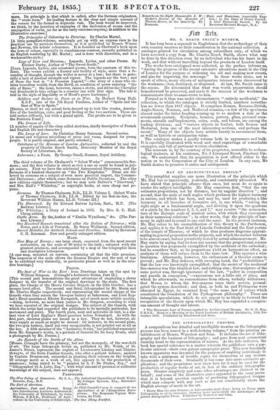Fi lriff.
MR. C. ROACH SMITH'S MUSEUM.
It has long been a reproach to Englishmen that the archmology of their own country receives so little consideration in the national collection. A catalogue printed for circulation among subscribers only, of which we have received a copy from Mr. Charles Roach Smith, shows what may be done in this direction even by an individual who has his heart in the work, and that without travelling beyond the precincts of London itself.
The works here catalogued were collected, as the preface informs us, " during the progress of the recent extensive alterations made in the City of London for the purpose of widening the old and making new streets, and also for improving the sewerage." In these works alone, not to speak of others, many objects of antiquarian interest were discovered by the workmen—lost, destroyed, or dispersed. At last, Mr. Smith came to the rescue. He determined that what was worth preservation should henceforward be preserved, and made it the interest of the workmen to communicate their treasure-trove to him.
Formed as it thus was under circumstances " entirely accidental," the collection, to which the catalogue is strictly limited, numbers neverthe- less no fewer than 1017 objects. It comprises Roman, Romano-British, Anglo-Saxon, Norman, and Mediaeval remains,—a few of the specimens classed under the latter heading coming up to so modern a date as the seventeenth century. Sculpture, bronzes, pottery, glass, personal orna- ments, utensils and'implements, coins, seals, and tokens, are among the leading divisions ; and " various objects in leather, both Roman and Mediaeval, form one of the most interesting sections, and perhaps tho rarest." Many of the objects have artistic beauty to recommend them, as well as historic or antiquarian value. The catalogue makes a goodly volume both in appearance and bulk. It is carefully illustrated with wood and steel engravings of remarkable examples, and full of pertinent written elucidation. The museum is, by the courtesy of its proprietor, accessible to archaeo- logical students, at his residence, No. 5 Liverpool Street, Finsbury Cir- cus. We understand that its acquisition is now offered either to the nation or to the Corporation of the City of London. In any case, Mr Smith desires to preserve it entire and undispersed.


































 Previous page
Previous page